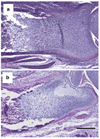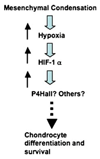Extracellular matrix genes as hypoxia-inducible targets
- PMID: 19662436
- PMCID: PMC3074490
- DOI: 10.1007/s00441-009-0841-7
Extracellular matrix genes as hypoxia-inducible targets
Abstract
Low oxygen tension, i.e., hypoxia, is a pathophysiological component involved in many human disorders but is also a critically important phenomenon in normal development and differentiation. The ability of cells to survive under hypoxia or to adapt to it depends on a family of hypoxia-inducible transcription factors (HIFs) that induce the expression of a number of genes involved in hematopoiesis, angiogenesis, iron transport, glucose utilization, resistance to oxidative stress, cell proliferation, survival and apoptosis, and extracellular matrix homeostasis. We introduce here the recently identified molecular mechanisms responsible for the oxygen-dependent stability and activity of HIF, after which we focus on extracellular matrix genes as HIF targets. The vital role of the hypoxia response pathway in chondrogenesis and joint development is then discussed.
Figures






References
-
- Amarilio R, Viukov SV, Sharir A, Eshkar-Oren I, Johnson RS, Zelzer E. HIF1α regulation of Sox9 is necessary to maintain differentiation of hypoxic prechondrogenic cells during early skeletogenesis. Development. 2007;134:3917–3928. - PubMed
-
- Berg JT, Breen EC, Fu Z, Mathieu-Costello O, West JB. Alveolar hypoxia increases gene expression of extracellular matrix proteins and platelet-derived growth factor-B in lung parenchyma. Am J Respir Crit Care Med. 1998;158:1921–1928. - PubMed
-
- tenBerge D, Brouwer A, Korving J, Martin JF, Meijlink F. Prx1 and Prx2 in skeletogenesis: roles in the craniofacial region, inner ear and limbs. Development. 1998;125:3831–3842. - PubMed
Publication types
MeSH terms
Substances
Grants and funding
LinkOut - more resources
Full Text Sources

